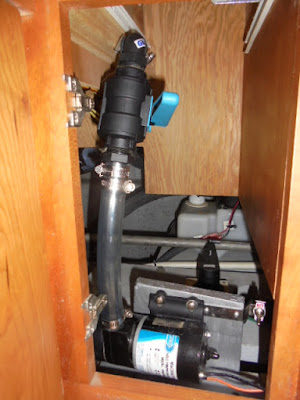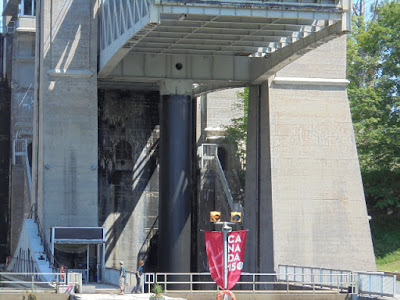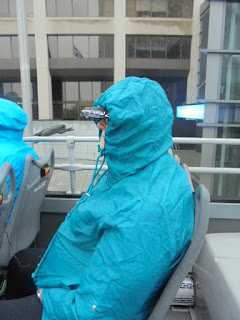Since we bought Loopy Kiwi in
2011, we have been plagued with the odour of sewage in the master stateroom. It
was particularly noticeable as the tank filled and worst on the starboard side
– to the extent that clothing in the bed and vanity drawers was being affected.
It was obvious that this had been ongoing since new, as there were a number of
deodorant plug-ins situated around the boat by the previous owner. The use of Noflex reduced the smell significantly and replacing the
undersized and blocked vents (which I have already posted earlier on this blog) also helped, but the odour issue has remained as a frustrating annoyance.
There are other problems with
the design of the sewage discharge system, such as siphoning of seawater back
through the macerator and the susceptibility to the outlet becoming blocked
with marine growth because the underwater thru hull reduces the 1” pump outlet
to a mere ½” hole in the hull. I also knew that there was a kink in the
dockside discharge hose that may have been contributing to pumpout problems. A few months ago, I
drew up a map of the sewage system and, looking at the layout and
knowing the fall (or lack of it) in the 7.2 metres of discharge hose, it seemed
obvious to me that areas of the pipework were remaining full of effluent
resulting in the smell permeating the hoses.
The final rankle was the
actual procedure required to discharge overboard at sea using the macerator: To
prevent the siphoning mentioned above, I kept the macerator seacock closed. It
is situated on the outboard side of the port propeller shaft, so it is good
practice to be stopped when opening it. So we have to stop the boat 2km out to
sea (we are required to be that far offshore when we discharge), I have to go from the helm down to the engine room, via the sundeck, salon, hallway and guest bedroom and open the valve, return to the AC/DC panel in the hallway, switch on the macerator and sit and watch the ammeter until it flickers to show
that it is pumping air (the only way I know of to know that the tank is
completely empty). It takes around 10 minutes to empty a full tank and it is
rarely flat calm 2kms offshore. I then have to go back into the engine room and
close the seacock before returning to the helm and getting underway again - a total trek of around 50 metres (seriously) and up and down 3 flights or stairs.
Remaining underway makes things more comfortable, but that requires even more
stair time to co-ordinate stopping and starting with the co-pilot to open the seacock safely.
I have installed and
modified holding tank systems in both my previous boats (which could be discharged without leaving the helm), so I decided I would
try and line all the ducks up and fix the odour, siphoning, blockages and user
un-friendliness in one swoop. A word of caution here to other 453 owners: doing
this modification requires access to the rear of the holding tank in the
transom space behind the bedhead. I am lucky that in order to make my boat “NZ
electric” I removed both cablemasters from that spot which gives easy access,
particularly for a little guy like my good friend, Charlie. On the Silverton Owners Club forum, a member recently posted a video showing that accessing this area is quite doable with a single Cablemaster. However if you have 2 cablemasters it would be difficult, if not impossible, to access the aft bilge and do the modification
as I did.
We did this while on the
hardstand last week when we came out to re-caulk the rubrail, antifoul and polish, so the boat was propped up in a more stern-down attitude than it
would be on the water. We had a pumpout before we were lifted, and another on the hard, to remove as much
effluent from the tank as possible.
The first act was to remove
the hose between the macerator and the transom pumpout fitting. The transom end
is easy to access by removing the mirror in the master bathroom. The pump end is also readily
accessible, although it is necessary to demount the pump to get at the hose
clips on the Tee piece that connects to it. I was hoping that when the hose
disappeared into the bulkhead and behind the bath that we could simply pull the
hose through. Unfortunately, when we took a pic of the space, we found the hose
was cable tied to each hull frame all the way through.
I figured we could perhaps
reach them by removing the gauge panel under the sink. I took all the screws
out and the panel could move, but cannot be taken out without removing the
front of the cabinet – which we never found out how to do. However, we DID find
that the panel beside the toilet was removable – it was siliconed to the shelf
and the RH side – but once we cut through that it could be simply pulled off.
It is attached with those snap in clips like other removable panels in the
master stateroom.
I could reach the first 2
cable ties and Charlie could reach one from the other end. But to get to the 2
remaining ones required us to make a special tool, which we used to saw through the "buckles" on the cable ties, rather than the "straps". The weight of the saw puts load on the blade so you only need to be able to push and pull to cut through the ties.
Once done, we taped up the
ends of the hose with duct tape and pulled it up through the mirror hole and
out the portlet onto the ground. I had slightly underestimated that piece in my
map – it was a little over 6 metres long. We tied each end to one of the Acrow
props holding the boat and filled it full of water and Noflex to percolate for
several hours.
We then disconnected the
hose from the macerator while holding the pump up – it is a low point and
contains effluent. We taped the opening and pulled it through into the
bilge at the bottom of the stairs. While it was down low, we cut the tank end
of the hose just short of where it passes through the engine bed rail. We then
put a bucket under the end and lifted the other end of the hose through the
hatch to drain it – about 10 litres of effluent came from it. We flushed it out
with fresh water then sealed the aft end and added Noflex, which we left for
several hours.
We then pushed the aft end through
to the other side of the engine bed to get a straight pull at it, but no amount
of pull could get it to even look like moving so we cut the pump end off as
short as possible and sealed both ends with plastic bungs. The 2.5 metres that
we cut off absolutely reeked both inside and out and was immediately thrown in
the bin.
By this time I had figured
that the other length of hose we had removed was in good enough condition to
reuse instead of replacing it with solid pipe as I originally intended and, as
it would now be installed with continuous fall back to the tank, there was
little danger of permeation due to it holding effluent. We also reused the Tee
and the original macerator and added a valve to the inlet of the pump (it is
there to stop smell coming up the pipe if the pump is ever removed as both it
and the pump are above the level of the full tank). We installed a 1” thru hull
about 4” above the waterline and the macerator discharges through it. There is
also a valve in that line, adjacent to the pump, which can be closed during
dockside pumpout to prevent air being sucked in to the discharge pipes. The
first section of hose from the pump is clear plastic so I can see when the
discharge stops. The feed from the AC/DC panel is continuous (I used the old
cablemaster supply) and there is an on/off switch beside the pump, which is
conveniently located in a cabinet beside the master bed.
So the discharge procedure will now be: Go 2km out to sea. Leave a co-pilot in charge of the boat. Go to the master stateroom (still 3 flights of stairs, but less distance), open the valve and turn on the switch. Watch the gauge drop (you can see it from the pump position) and watch till the sight glass empties. Switch the pump off, close the valve and go back to the helm. Ideally, I would like to have a stop/start station for the pump at the helm, as I had on my previous boats. I have already purchased the components to do this, but I would need to be sure that I had a method of knowing that the tank was completely empty before installing it.
The old macerator position
provided a thru hull and power supply for another project I had been meaning to
do for some time, and that was to fit a salt water washdown pump. We mounted the
new pump where the macerator had been (even used some of the mounting holes) and
used the outlet hose as the washdown inlet. We ran the outlet to a tap on the
transom via the route that the old sewage discharge hose had taken and mounted
it behind our outboard bracket, where it is easy to get to but protected. I am
considering taking a supply from this to a valve that can rinse out the
macerator discharge hose, or the holding tank, or both – but will wait and see
how it works out first.
I guess time alone will tell how successful the modification is, but I am supremely confident it won't make things any worse!



































































